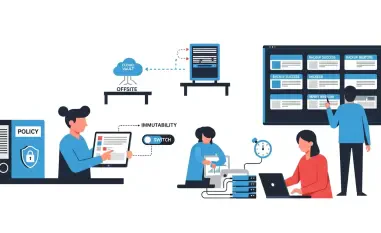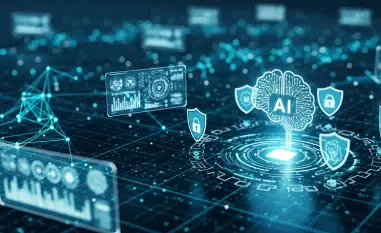Setting the Stage for a Digital Defense Revolution
Imagine a world where cyber threats evolve faster than human defenders can react, with attacks striking at the speed of algorithms and bypassing traditional security measures with eerie precision. This is the reality of modern cybersecurity, where artificial intelligence (AI) has emerged as both a formidable shield and a double-edged sword. With 78% of organizations integrating AI into at least one business function as of this year, the stakes for securing digital ecosystems have never been higher. This review delves into the transformative role of AI in cybersecurity, examining its capabilities, real-world impact, and the challenges that accompany its rapid adoption. The aim is to provide a clear, in-depth analysis of how this technology is reshaping enterprise security strategies.
Core Features and Capabilities of AI in Cybersecurity
Threat Detection and Rapid Response
AI’s standout feature in cybersecurity lies in its ability to detect and respond to threats with unprecedented speed. By leveraging machine learning and behavioral analysis, AI systems can identify anomalies that signal potential breaches, often before they escalate into full-scale attacks. These tools analyze vast datasets in real time, flagging suspicious patterns that might elude human oversight. Performance metrics highlight detection speeds that outpace manual methods, alongside accuracy rates that minimize false positives in complex environments.
Beyond detection, AI excels in automating incident response, reducing the time between threat identification and mitigation. This capability is critical in high-stakes scenarios where every second counts, such as ransomware attacks targeting critical infrastructure. However, the effectiveness of these systems often depends on the quality of data they are trained on, underscoring the need for robust input to maintain reliability.
Vulnerability Identification and Risk Management
Another key strength of AI is its proficiency in uncovering software vulnerabilities and system weaknesses at a scale unattainable by traditional scans. Tools powered by AI can prioritize risks based on severity, enabling security teams to focus on critical flaws first. This rapid assessment is vital in environments with sprawling digital assets, where manual checks would be impractical.
Despite these advantages, challenges persist in translating detection into action. A significant lag often exists in patching identified vulnerabilities, particularly in legacy systems, leaving windows of opportunity for adversaries. This gap between discovery and remediation remains a pressing concern, as cybercriminals can exploit flaws faster than many organizations can respond.
Performance in Real-World Applications
Sector-Specific Implementations
AI’s impact on cybersecurity is evident across diverse industries, from finance to healthcare, where it enhances endpoint security and threat monitoring. In financial institutions, AI-driven systems scrutinize transaction patterns to detect fraud in real time, protecting sensitive data from unauthorized access. Similarly, in healthcare, AI safeguards patient records by identifying unusual network activity that could indicate a breach.
In critical infrastructure, AI plays a pivotal role in defending against attacks that could disrupt essential services. Security operations centers (SOCs) in these sectors rely on AI to process massive volumes of alerts, ensuring that human analysts focus on the most urgent threats. These applications demonstrate AI’s versatility in addressing sector-specific risks with tailored solutions.
Case Studies of Success and Struggle
Notable implementations reveal both the promise and pitfalls of AI in action. In one instance, an enterprise SOC successfully thwarted a sophisticated phishing campaign by using AI to detect subtle deviations in email content, preventing data loss. This case underscores the technology’s potential when integrated with human expertise.
Conversely, vulnerabilities in AI tools themselves have led to significant setbacks. A flaw dubbed “ShadowLeak” in a widely used AI platform allowed attackers to extract sensitive information through hidden code, bypassing network defenses. Although the issue was resolved, it exposed the risks inherent in trusting AI systems without rigorous oversight, highlighting a critical area for improvement.
Challenges and Risks in Deployment
Technical and Adversarial Threats
While AI offers powerful defensive capabilities, it is not without vulnerabilities that adversaries can exploit. Technical flaws in AI systems, such as those seen in high-profile incidents, pose a real danger to organizations that rely on them. Cybercriminals have also begun weaponizing AI, crafting advanced attacks like deepfakes that target identity verification processes.
The pace of offensive AI development often outstrips defensive readiness, as reported by IT leaders, with only a small fraction expressing confidence in their current capabilities. This disparity creates a precarious balance, where the same technology that protects can also be turned against its users, necessitating constant vigilance.
Ethical and Regulatory Concerns
Beyond technical issues, the integration of AI in cybersecurity raises ethical and regulatory questions. The potential for misuse, whether through invasive surveillance or biased algorithms, demands careful consideration of privacy implications. Governments and industry bodies are grappling with how to govern AI use without stifling innovation.
Compliance with emerging standards adds another layer of complexity for organizations deploying AI tools. Balancing security needs with ethical obligations remains a challenge, as does ensuring transparency in how AI decisions are made. These concerns must be addressed to build trust in AI-driven defenses.
Looking Back and Moving Forward
Reflecting on the journey of AI in cybersecurity, it has become clear that this technology has reshaped the landscape of digital defense with remarkable speed and scale. Its ability to detect threats, identify vulnerabilities, and automate responses marks a significant leap forward, offering hope against increasingly sophisticated attacks. Yet, the risks—ranging from exploitable flaws to adversarial misuse—serve as stark reminders of its limitations during implementation.
Looking ahead, organizations need to prioritize multi-layered security frameworks that combine AI with human oversight to address vulnerabilities like those exposed in past incidents. Strengthening patch management processes is essential to close the gap between detection and remediation. Furthermore, adopting zero trust principles, with a focus on rigorous identity verification, emerges as a vital strategy to counter AI-enhanced threats. As the battle against cybercrime continues, investing in adaptive defenses and fostering collaboration across industries promises to be the most effective path toward a more secure digital future.













